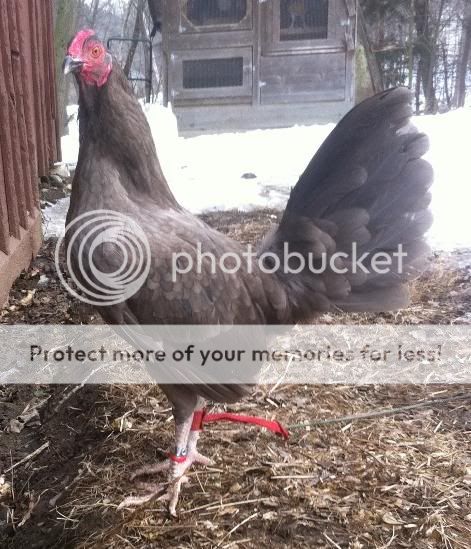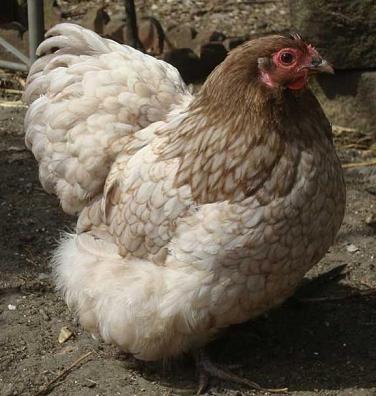Quote:
Genetics 202
In the chickens skin are special cells called melanocytes, these cells are where the pigments are made. The pigments are made and packaged in cell structures called melanosomes. A house is a cell and beach balls in the house are melanosomes. There are two kinds of melanosomes: eumelanosomes make and package black pigment (eumelanin) while pheomelanosomes make and package red pigment (pheomelanin).
Eumelanosomes have a well organized matrix (lots of framing like walls in a house) and are rod shaped in black areas of a bird; blue birds have eumelanosomes that are round.
Pheomelanosomes are not well organized and round.
The melanocytes have the ability to migrate. They move up to ( migrate from the dermis) and park next to a cell (in the skin) called a keratinocyte. The melanocytes then transfer the melanosomes to the keratinocytes. The keratinocytes then transfer the pigment to the growing feather.
A blue birds feathers contain a modified eumelanin (it has different chemical properties than black eumelanin) and the eumelanosomes are round. The eumelanosomes are loosely packed into the different parts of the feather- some parts do not contain eumelanosomes (hooks).
Black areas on birds contain eumelanin and the eumelanosomes are rod shaped. Eumelanosomes are tightly packed into the different parts of a feather.
Lavender birds have normal melanosomes. The melanocytes (pigment making cells) are normal. The lavender gene inhibits the transfer of the eumelanosomes and pheomelanosomes from the melanocyte to the keratinocyte. Normally the melanosomes travel from the center of the melanocyte to little fingers that stick out from the cell (dendrites). The keratinocytes then accept the pigments from the dendrites and place the pigments into the developing feather. Most of the pigment stays inside the melanocyte and does not make it to the feather follicle.
Dominant white- The dominant white gene interferes with how the eumelanosomes are produced (reduces the number of melanosomes made); causing them to be an irregular shape and to have an improper internal structure. The melanocyte does not recognize the eumelanosomes so the melanocyte destroys the eumelanosomes; they think the eumelanosomes are foreign and do not belong inside the cell.
I would hypothesize that the dun gene works similar to the dominant white gene. The mechanism does not work as well- some of the melanosomes are not recognized as foreign (pigments make it to the feather follicle) and others are recognized as foreign and are destroyed. This would produce a diluted color.
Tim
Genetics 202
In the chickens skin are special cells called melanocytes, these cells are where the pigments are made. The pigments are made and packaged in cell structures called melanosomes. A house is a cell and beach balls in the house are melanosomes. There are two kinds of melanosomes: eumelanosomes make and package black pigment (eumelanin) while pheomelanosomes make and package red pigment (pheomelanin).
Eumelanosomes have a well organized matrix (lots of framing like walls in a house) and are rod shaped in black areas of a bird; blue birds have eumelanosomes that are round.
Pheomelanosomes are not well organized and round.
The melanocytes have the ability to migrate. They move up to ( migrate from the dermis) and park next to a cell (in the skin) called a keratinocyte. The melanocytes then transfer the melanosomes to the keratinocytes. The keratinocytes then transfer the pigment to the growing feather.
A blue birds feathers contain a modified eumelanin (it has different chemical properties than black eumelanin) and the eumelanosomes are round. The eumelanosomes are loosely packed into the different parts of the feather- some parts do not contain eumelanosomes (hooks).
Black areas on birds contain eumelanin and the eumelanosomes are rod shaped. Eumelanosomes are tightly packed into the different parts of a feather.
Lavender birds have normal melanosomes. The melanocytes (pigment making cells) are normal. The lavender gene inhibits the transfer of the eumelanosomes and pheomelanosomes from the melanocyte to the keratinocyte. Normally the melanosomes travel from the center of the melanocyte to little fingers that stick out from the cell (dendrites). The keratinocytes then accept the pigments from the dendrites and place the pigments into the developing feather. Most of the pigment stays inside the melanocyte and does not make it to the feather follicle.
Dominant white- The dominant white gene interferes with how the eumelanosomes are produced (reduces the number of melanosomes made); causing them to be an irregular shape and to have an improper internal structure. The melanocyte does not recognize the eumelanosomes so the melanocyte destroys the eumelanosomes; they think the eumelanosomes are foreign and do not belong inside the cell.
I would hypothesize that the dun gene works similar to the dominant white gene. The mechanism does not work as well- some of the melanosomes are not recognized as foreign (pigments make it to the feather follicle) and others are recognized as foreign and are destroyed. This would produce a diluted color.
Tim
Last edited:





